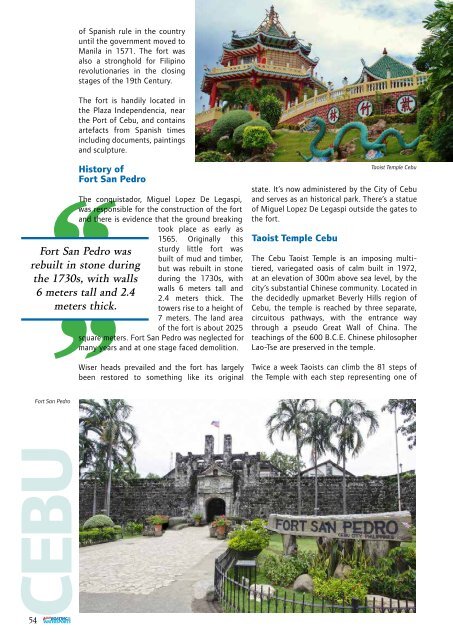ABW Dec 2017
Create successful ePaper yourself
Turn your PDF publications into a flip-book with our unique Google optimized e-Paper software.
of Spanish rule in the country<br />
until the government moved to<br />
Manila in 1571. The fort was<br />
also a stronghold for Filipino<br />
revolutionaries in the closing<br />
stages of the 19th Century.<br />
The fort is handily located in<br />
the Plaza Independencia, near<br />
the Port of Cebu, and contains<br />
artefacts from Spanish times<br />
including documents, paintings<br />
and sculpture.<br />
History of<br />
Fort San Pedro<br />
The conquistador, Miguel Lopez De Legaspi,<br />
was responsible for the construction of the fort<br />
and there is evidence that the ground breaking<br />
took place as early as<br />
1565. Originally this<br />
Fort San Pedro was<br />
rebuilt in stone during<br />
the 1730s, with walls<br />
6 meters tall and 2.4<br />
meters thick.<br />
sturdy little fort was<br />
built of mud and timber,<br />
but was rebuilt in stone<br />
during the 1730s, with<br />
walls 6 meters tall and<br />
2.4 meters thick. The<br />
towers rise to a height of<br />
7 meters. The land area<br />
of the fort is about 2025<br />
square meters. Fort San Pedro was neglected for<br />
many years and at one stage faced demolition.<br />
Wiser heads prevailed and the fort has largely<br />
been restored to something like its original<br />
state. It’s now administered by the City of Cebu<br />
and serves as an historical park. There’s a statue<br />
of Miguel Lopez De Legaspi outside the gates to<br />
the fort.<br />
Taoist Temple Cebu<br />
Taoist Temple Cebu<br />
The Cebu Taoist Temple is an imposing multitiered,<br />
variegated oasis of calm built in 1972,<br />
at an elevation of 300m above sea level, by the<br />
city’s substantial Chinese community. Located in<br />
the decidedly upmarket Beverly Hills region of<br />
Cebu, the temple is reached by three separate,<br />
circuitous pathways, with the entrance way<br />
through a pseudo Great Wall of China. The<br />
teachings of the 600 B.C.E. Chinese philosopher<br />
Lao-Tse are preserved in the temple.<br />
Twice a week Taoists can climb the 81 steps of<br />
the Temple with each step representing one of<br />
Fort San Pedro<br />
CEBU<br />
54


















